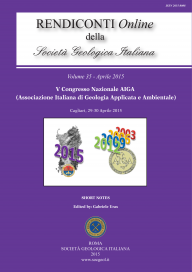
Hydrological behavior of ash-fall pyroclastic soil mantled slopes of the Sarno Mountains (Campania - southern Italy)
Francesco Fusco (1) & Pantaleone De Vita (1)
(1) Dipartimento di Scienze della Terra, dell'Ambiente e delle Risorse - University of Naples "Federico II".
Volume: 35/2015
Pages: 148-151
Abstract
The instability of ash-fall pyroclastic deposits that mantle mountain ranges around the Mount Somma-Vesuvius (Campania, southern Italy) are well known to represent a main geological hazard due to their frequent involvement in shallow flow-like landslides, triggered by high-intensity and prolonged rainfall. In such a geomorphological framework, which is similar to other mountain areas that surround volcanic centers of the world, the comprehension of hydrological dynamics occurring into pyroclastic deposits is a key factor for assessing and modelling the landslide hazard. Despite the general relevance of hydrological analysis in studying shallow landslides, this type of approach is particularly significant for pyroclastic soils due to their special hydrological properties and complex stratigraphic settings. Along with this goal, in a test area of the Sarno Mountains, upslope of a debris flow source area, a monitoring station was installed to assess hydrological processes that predispose and lead to landslide triggering. Monitoring data, covering about three hydrological years (Dec. 2010 - Dec. 2013), showed a regime of pore pressures always ranging in unsaturated conditions. Marked seasonal and interannual variations of pore pressure were observed at different depths with respectively delayed and damped dynamics. These observations were correlated to rainfall patterns and the evapotranspiration regime, which is concentrated during the activity period of the existing deciduous forest. Results of this approach allow understanding hydrological processes at slope scale, to set and calibrate numerical models for estimating rainfall thresholds by a deterministic approach as well as to assess landslide hazard.
Keywords
Get Full Text